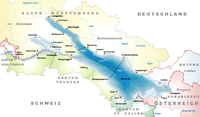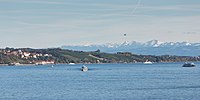Hegau
You can help expand this article with text translated from the corresponding article in German. (February 2009) Click [show] for important translation instructions.
|
 | |
| Area | 306 km² |
|---|---|
| Classification | Handbook of Natural Region Divisions of Germany |
| Highest point | 867.2 m (2,845 ft) |
| County/District | Konstanz district, Tuttlingen district, Schwarzwald-Baar |
| State(s) | Baden-Württemberg |
| Country | Germany |
Hegau either refers to a region of the Duchy of Swabia or to only that part of said region which is presently located in the country of Germany. It is known for its extinct, partly eroded volcanoes, most of which are crowned with ruins of medieval fortresses.
Historically, Hegau was a Gau of the Duchy of Swabia, first mentioned in 787 A.D. in the Latinised form in pago Egauinsse.[1] Its area reached from the Überlinger See of Lake Constance and the city of Konstanz in the east to the Randen and Schaffhausen in the present-day Swiss canton of Schaffhausen in the west. Towards south, it extended to the High Rhine and to the north until the Danube.
Today, Hegau refers only to that part of the former Gau which is located within the German state of Baden-Württemberg. This region, also called the Hegauer Kegelbergland (lit. 'Hegau cone hill landscape'), is a Young Drift morainic landscape marked by the remains of several extinct volcanoes, the Hegau volcanoes, which are located mostly to the west and east of the line from Singen (Hohentwiel) in the south to Geisingen in the north. The Hegau volcanoes are national geotopes of Germany.[2]
Origin of the landscape[edit]
The Hegau region, situated at about 400 m (1,300 ft) a.s.l., is surmounted by nearly a dozen conical hills, which are between 643 m (2,110 ft) and 867 m (2,844 ft) high and which correspond to the remains of the pipes of past volcanoes. The area was volcanically active during the Miocene epoch, from about 14 Ma ago to around 6 Ma ago.[3] Much later, during the Riss glaciation (Pleistocene epoch), about 150 ka ago, the Hegau region was covered by large glaciers, which over time eroded the softer rocks around the harder basaltic rocks of the former volcanic pipes (an example of an inverted relief). After the melting of the ice age glaciers, the landscape received its typical, modern-day appearance.[4][5]
In conjunction with the past volcanisms, several maars formed in the area, which later filled with water to form lakes. The sediments of these maar lakes preserve exceptional fossils, for example of the early horse Hippotherium primigenium or of the giant salamander Andrias scheuchzeri.[2]
During the Middle Ages, fortresses were built on top of several Hegau volcanoes.[2]
The arguably best-known of the Hegau volcanoes is the Hohentwiel, on top of which lie the ruins of a fortress of the same name. The Hohentwiel is located next to the industrial city of Singen. It is the southernmost of the Hegau volcanoes. To the north of it, there are nine other extinct volcanoes (see list below).
List of Hegau volcanoes[edit]
| Moutain name | Altitude (a.s.l.) | Notes | Image |
|---|---|---|---|
| Blauer Stein | 836 m (2,743 ft) | Located near the vilage of Randen (Blumberg); its name means "blue rock" in German | 
|
| Hohenhewen | 843.7 m (2,768 ft) | Located near Engen, with fortress ruins on top | 
|
| Hohenkrähen | 644 m (2,113 ft) | Located near Duchtlingen, with fortress ruins on top | 
|
| Hohenstoffeln | 841.8 m (2,762 ft) / 832 m (2,730 ft) | Located between Binningen and Weiterdingen (Hilzingen), with double summit | 
|
| Hohentwiel | 686 m (2,251 ft) | Located near Singen, with ruins of Hohentwiel Castle on top | 
|
| Höwenegg | 798 m (2,618 ft) | Located south of Immendingen, with two fortress ruins on top | 
|
| Mägdeberg | 654.2 m (2,146 ft) | Located near Mühlhausen-Ehingen, with fortress ruins on top | 
|
| Neuhewen | 867.2 m (2,845 ft) | Located near Stetten (Engen), with fortress ruins on top | 
|
| Staufen | 594 m (1,949 ft) | Located near Hilzingen, with fortress ruins on top | 
|
| Wartenberg | 844.8 m (2,772 ft) | Located near Geisingen, the northernmost of the Hegau volcanoes | 
|
References[edit]
- ^ Albert Krieger: Topographisches Wörterbuch des Großherzogtums Baden, Vol. 1, p. 882 (1904)
- ^ a b c "Hegau-Vulkane" (in German). LGRBwissen. Retrieved 2 June 2024.
- ^ "Vulkane im Hegau" (in German). geotourist-freiburg.de. Retrieved 2 June 2024.
- ^ Geyer, Matthias; Gies, Nils (2021). Hegau – Geologie der Vulkanlandschaft zwischen Donau und Bodensee. Sammlung geologischer Führer (in German). Vol. 113. Stuttgart: Gebrüder Borntraeger. ISBN 978-3-443-15104-1.
- ^ Baier, Johannes; Scherzinger, Armin (2021). "Das Vulkanfeld im Hegau". Aufschluss. 72 (2): 58–69..
External links[edit]
 Media related to Hegau at Wikimedia Commons
Media related to Hegau at Wikimedia Commons- "Hegau-Vulkane" (in German). LGRBwissen. Retrieved 1 June 2024.
47°47′42″N 8°45′00″E / 47.795°N 8.750°E



